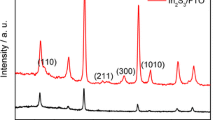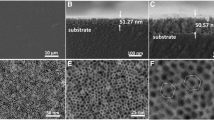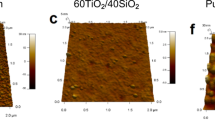Abstract
Free-standing nano-porous SiO2 films with high porosity on the scale of hundreds of microns were obtained by combing a parting agent method and layer-by-layer assembly method where betaine was employed as soluble layer and PAMS (poly-α-methylstyrene) was used as protective and thermal degradation sacrificial layer, respectively. The surface morphology, roughness, chemical composition and physical properties of the films were studied in this work. The thermal degradation property of PAMS and its effect on the preparation of free-standing film were also analyzed. The results indicated that the PAMS effectively protected the SiO2 films from damage during the detachment and transfer processes, and it can be completely removed after the film being calcined at 330 °C for 4 h. The thickness of the SiO2 films can be adjusted between 534 and 297 nm. Before calcination, the SiO2 film was hydrophobic and the process of dissolving betaine would not damage its structure nor influence its smoothness. After being calcined, the SiO2 film became hydrophilic, the refractive index increased from 1.19 to 1.20, and the porosity decreased from 56 to 53 %; the calcination process contributed to progress condensation of the polysiloxane network and removed organic groups from silica film. Employing PAMS as protective and thermal degradation sacrificial layer provides a new approach for preparation of other large-area free-standing films.
Graphical Abstract











Similar content being viewed by others
References
Lommel B, Hartmann W, Kindler B, Klemm J, Steiner J (2002) Preparation of self-supporting carbon thin films. Nucl Instrum Methods A 480(1):199–203
Liechtenstein VK, Ivkova TM, Olshanski ED, Golser R, Kutschera W, Steier P, Vockenhuber C, Repnow R, Hahn R, Friedrich M, Kreissig U (2004) Recent investigations and applications of thin diamond-like carbon (DLC) foils. Nucl Instrum Methods A 521(1):197–202
Méens A, Nicoli MP, Raiser D (1997) Self-supporting beryllium oxide targets. Nucl Instrum Methods A 397(1):64–67
Lommel B, Hartmann W, Huebner A, Kindler B, Steiner J (2011) Preparation of self-supporting nickel targets from 58Ni, 60Ni and 61Ni. Nucl Instrum Methods A 655(1):44–46
Zhu X, Zhou B, Du A, Chen K, Li Y, Zhang Z, Shen J, Wu G, Ni X (2012) Potential SiO2/CRF bilayer perturbation aerogel target for ICF hydrodynamic instability experiment. Fusion Eng Des 87(2):92–97
Levin J, Knoll L, Scheffel M, Schwalm D, Wester R, Wolf A, Baer A, Vager Z, Zajfman D, Liechtenstein VK (2000) Application of ultrathin diamond-like-carbon targets to Coulomb explosion imaging. Nucl Instrum Methods B 168(2):268–275
Innocenzi P, Malfatti L (2013) Mesoporous thin films: properties and applications. Chem Soc Rev 42(9):4198–4216
Feng D, Lv Y, Wu Z, Dou Y, Han L, Sun Z, Xia Y, Zheng G, Zhao D (2011) Free-standing mesoporous carbon thin films with highly ordered pore architectures for nanodevices. J Am Chem Soc 133(38):15148–15156
Sim JS, Shi J, Ramanathan S (2014) Ultra-thin freestanding ceria membranes: layer transfer techniques and high temperature conductivity studies. J Mater Chem A 2(44):19019–19028
Kerman K, Tallinen T, Ramanathan S, Mahadevan L (2013) Elastic configurations of self-supported oxide membranes for fuel cells. J Power Sources 22:359–366
Peng X, Jin J, Ericsson ME, Ichinose I (2007) General method for ultrathin free-standing films of nanofibrous composite materials. J Am Chem Soc 129(27):8625–8633
Nolte M, Schoeler B, Peyratout SC, Kurth DG, Fery A (2005) Filled microcavity arrays produced by polyelectrolyte multilayer membrane transfer. Adv Mater 17(13):1665–1669
Yang H, Coombs N, Dag Ö, Sokolov I, Ozin GA (1997) Free-standing mesoporous silica films; morphogenesis of channel and surface patterns. J Mater Chem 7(9):1755–1761
Yang B, Edler KJ (2009) Free-standing ordered mesoporous silica films synthesized with surfactant-polyelectrolyte complexes at the air/water interface. Chem Mater 21(7):1221–1231
Park SS, Shin JH, Zhao D, Ha C (2010) Free-standing and bridged amine-functionalized periodic mesoporous organosilica films. J Mater Chem 20(36):7854–7858
Zhang D, Ryu K, Liu X, Polikarpov E, Ly J, Tompson ME, Zhou C (2006) Transparent, conductive, and flexible carbon nanotube films and their application in organic light-emitting diodes. Nano Lett 6(9):1880–1886
Wu Z, Chen Z, Du X, Logan JM, Sippel J, Nikolou M, Kamaras K, Reynolds JR, Tanner DB, Hebard AF, Rinzler AG (2004) Transparent, conductive carbon nanotube films. Science 305(5688):1273–1276
Cheng J, Rathi SJ, Stradins P, Frey GL, Collinse RT, Williams SKR (2014) Free standing silica thin films with highly ordered perpendicular nanopores. RSC Adv 4(15):7627–7633
Ono SS, Decher G (2006) Preparation of ultrathin self-standing polyelectrolyte multilayer membranes at physiological conditions using pH-responsive film segments as sacrificial layers. Nano Lett 6(4):592–598
Komor PM (1972) A simple technique of producing thin carbon films. Nucl Instrum Methods 102(3):485–486
Fearon EM, Letts SA, Allison LM, Cook RC (1997) Adapting the decomposable mandrel technique to build specialty ICF targets. Fusion Sci Technol 31(4):406–410
McQuillan BW, Nikroo A, Steinman DA, Elsner FH, Czechowicz DG, Hoppe ML, Sixtus M, Miller EJ (1997) The PAMS/GDP process for production of ICF target mandrels. Fusion Sci Technol 31(4):381–384
Takagi M, Cook R, McQuillan B, Elsner F, Stephens R, Nikroo A, Gibson J, Paguio S (2002) Development of high quality poly (α-methylstyrene) mandrels for NIF. Fusion Sci Technol 41(3P1):278–285
McQuillan BW, Takagi M (2002) Removal of mode 10 surface ripples in ICF PAMS shells. Fusion Sci Technol 41(3P1):209–213
Schultz KR, Kaae JL, Miller WJ, Steinman DA, Stephens RB (1999) Status of inertial fusion target fabrication in the USA. Fusion Eng Des 44(1):441–448
Letts SA, Nissen AEH, Orthion PJ, Buckley SR, Fearon E, Chancellor C, Roberts CC, Parrish BK, Cook RC (2002) Vapor-deposited polyimide ablators for NIF: effects of deposition process parameters and solvent vapor smoothing on capsule surface finish. Fusion Sci Technol 41(3P1):268–277
Freitas VT, Fu L, Cojocariu AM, Cattoënet X, Bartlett JR, Parc RL, Bantignies JL, Man MWC, André PS, Ferreira RAS, Carlos LD (2015) Eu3+-based bridged silsesquioxanes for transparent luminescent solar concentrators. ACS Appl Mater Interface 7(16):8770–8778
Zhong Y, Zhou B, Gui J, Du A, Zhang Z, Shen J (2011) Fabrication of multilayer graded density peeled-carbon-aerogel target. Fusion Eng Des 86(2):238–243
Wang X, Shen J (2012) A review of contamination-resistant antireflective sol–gel coatings. J Sol-Gel Sci Technol 61(1):206–212
Kesmez Ö, Kiraz N, Burunkaya E, Camurlu HE, Asiltürk M, Arpac E (2010) Effect of amine catalysts on preparation of nanometric SiO2 particles and antireflective films via sol–gel method. J Sol-Gel Sci Technol 56(2):167–176
Li X, Zou L, Wu G, Shen J (2014) Laser-induced damage on ordered and amorphous sol–gel silica coatings. Opt Mater Express 4(12):2478–2483
Li X, Gross M, Green K, Oreb B, Shen J (2012) Ultraviolet laser-induced damage on fused silica substrate and its sol–gel coating. Opt Lett 37(12):2364–2366
Niu C, Wu X, Ren W, Chen X, Shi P (2015) Mechanical properties of low k SiO2 thin films templated by PVA. Ceram Int 41:S365–S369
Philipavičius J, Kazadojev I, Beganskienė A, Melninkaitis A, Sirutkaitis V, Kareiva A (2008) Hydrophobic antireflective silica coatings via sol–gel process. Mater Sci 14:283–287
Liu Y, Shen J, Zhou B, Wu G, Zhang Z (2013) Effect of hydrophobicity on the stability of sol–gel silica coatings in vacuum and their laser damage threshold. J Sol-Gel Sci Technol 68(1):81–87
Burkey DD, Gleason KK (2003) Structure and thermal properties of thin film poly (α-methylstyrene) deposited via plasma-enhanced chemical vapor deposition. Chem Vap Depos 9(2):65–71
Quijano AG, Huerta F, Torres DS, Morallón E, Montilla F (2015) Electrochemical behaviour of PSS-functionalized silica films prepared by electroassisted deposition of sol–gel precursors. Electrocatalysis 6(1):33–41
Innocenzi P, Falcaro P, Grosso D, Babonneau F (2003) Order-disorder transitions and evolution of silica structure in self-assembled mesostructured silica films studied through FTIR spectroscopy. J Phys Chem B 107(20):4711–4717
Wongcharee K, Brungs M, Chaplin R, Hong YJ, Pillar R, Sizgek E (2002) Sol–gel processing by aging and pore creator addition for porous silica antireflective coatings. J Sol-Gel Sci Technol 25(3):215–221
Joseph R, Zhang S, Ford WT (1996) Structure and dynamics of a colloidal silica-poly (methyl methacrylate) composite by 13C and 29Si MAS NMR spectroscopy. Macromolecules 29(4):1305–1312
Haukka S, Root A (1994) The reaction of hexamethyldisilazane and subsequent oxidation of trimethylsilyl groups on silica studied by solid-state NMR and FTIR. J Phys Chem 98(6):1695–1703
Li X, Shen J (2011) A scratch-resistant and hydrophobic broadband antireflective coating by sol–gel method. Thin Solid Films 519(19):6236–6240
Zou L, Li X, Zhang Q, Shen J (2014) An abrasion-resistant and broadband antireflective silica coating by block copolymer assisted sol–gel method. Langmuir 30(34):10481–10486
Li X, Shen J (2011) The stability of sol–gel silica coatings in vacuum with organic contaminants. J Sol-Gel Sci Technol 59(3):539–545
Du A, Zhou B, Zhang Z, Shen J (2013) A special material or a new state of matter: a review and reconsideration of the aerogel. Materials 6(3):941–968
Madras G, Smith JM, McCoy BJ (1996) Thermal degradation of poly (α-methylstyrene) in solution. Polym Degrad Stab 52(3):349–358
Acknowledgments
This work was supported by National High Technology Research and Development Program of China (2013AA031801), National Science and technology support program of China (2013BAJ01B01), Science and Technology Innovation Fund of Shanghai Aerospace, China (SAST201469). Also, the authors would like to thank Prof. Junxiao Yang and Xiaoguang Li for their assistance.
Author information
Authors and Affiliations
Corresponding authors
Rights and permissions
About this article
Cite this article
Xiang, Y., Wu, S., Du, A. et al. A new approach for preparation of free-standing nano-porous SiO2 films with a large area. J Sol-Gel Sci Technol 80, 267–276 (2016). https://doi.org/10.1007/s10971-016-4123-z
Received:
Accepted:
Published:
Issue Date:
DOI: https://doi.org/10.1007/s10971-016-4123-z




